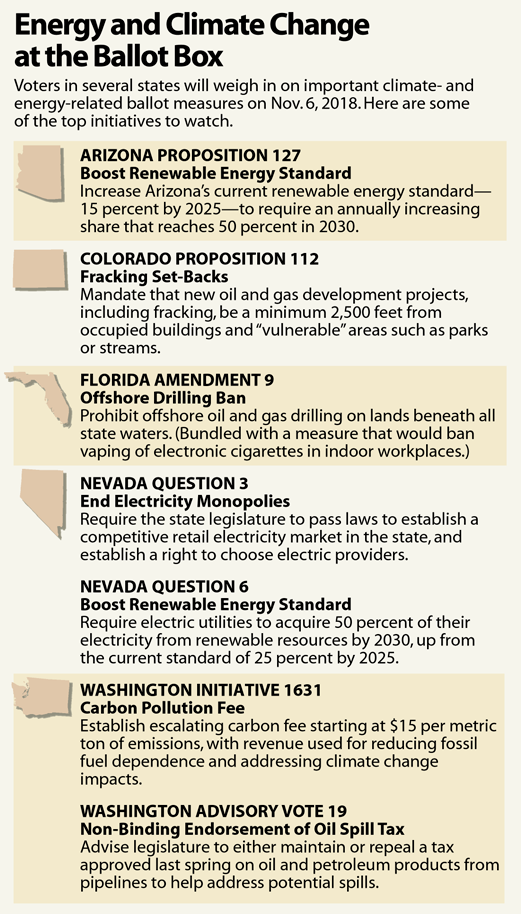Washington state’s ballot in 2016 included a provision asking voters if they would approve a carbon tax, but the initiative failed with 59 percent of the voters opposing the measure. This November, the state will try again to solicit favorable votes from the state’s electorate for approval of a tax on carbon dioxide. The carbon tax plan would require fossil-fuel companies to pay $15 per ton of carbon dioxide they release into the atmosphere starting in 2020. The tax would increase by $2 annually (plus inflation) until 2035, when it would reach about $55 per ton. The goal is to reduce greenhouse gas emissions by 20 million metric tons (about 25 percent) by 2035. That would equate to reducing global emissions by 0.02 percent in 2035.
The ballot will word the plan as a carbon fee, not a tax, to make the initiative more appealing to voters and because money raised from a fee cannot be diverted to programs without an ostensible relationship to climate policy, according to Washington state law. The latter makes it more palatable to environmental, labor, tribal, and social justice groups, who did not like the revenue-neutral plan on the 2016 ballot, which would have offset other taxes.
The fee is estimated to bring in about $1 billion annually by 2023. If passed, the revenues will be spent on projects, such as wind and solar plants, mass transit, and energy-efficiency improvements to buildings. A smaller amount (10 percent) would support rural and poor communities thought to be most vulnerable to climate change and the higher cost of energy products that would result from the “fee.” At least $50 million would be spent on imperiled workers in fossil fuels. Washington processes crude from North Dakota’s Bakken Shale, ranking fifth in the country in oil refining.
The tax is expected to raise gasoline prices by 13 cents a gallon in 2020 and 59 cents a gallon by 2035. Washington has the third highest gasoline prices in the country after Hawaii and California. An analysis by National Economic Research Associates estimates that the tax would cost Washington households on average $440 in 2020 and increase to $990 by 2035. It would reduce state economic growth by 0.4 percent over the next two years.
The proposal exempts about 20 industries that are declared crucial to the state and whose products would become uncompetitive overseas due to their higher cost as a result of the carbon tax. The protected industries include pulp and paper mills, glass, iron, aluminum, cement, and Washington’s only active coal plant, TransAlta’s Centralia generating station, whose owners plan to close it by 2025. Refineries and the oil and gas industry are not exempt from the carbon tax.
Because Washington gets most of its electricity from hydropower, the biggest emissions reductions would come from the transportation sector due to projects to electrify transportation, subsidizing drivers to purchase electric vehicles and encouraging residents to use more mass transit.
Other State Climate and Energy Initiatives
California is the only U.S. state currently to have a carbon pricing plan, which imposes a cap-and-trade system that began in 2012. Some states in the northeast (Connecticut, Delaware, Maine, Maryland, Massachusetts, New Hampshire, New York, Rhode Island, Vermont) are members of the Regional Greenhouse Gas Initiative, whose function is to reduce and cap carbon dioxide emissions from the power sector. Several states have measures concerning energy and the environment on this year’s ballot, including:

Washington’s neighbor, the Canadian province of British Columbia, instituted a carbon tax 10 years ago that is about twice as expensive as Washington’s proposed starting fee, and it increases faster than Washington’s initiative. But, the province’s carbon emissions have been reduced by only 2 percent since 2007, when the fee was adopted. Its goal is to reduce emissions by 33 percent by 2020 from 2007 levels.
Conclusion
Washington’s carbon tax, if it passes, will have consumers paying the lion’s share of the tax through higher prices for gasoline, heating oil and other products. And, it will not do much for climate change since global emissions are expected to be reduced by just 0.02 percent in 2035. Washington voters should think carefully about the initiative if they do not want to pay much higher prices for energy with very little benefit.



